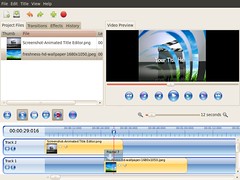Video in HTML5, via GIMP

At a hyperlocal LUG workshop last Tuesday, I had planned to go through some basic 'Photoshop' techniques, using the immense and groovy GNU IMP (as GNU IMP is increasingly able to replace Photoshop). Alas, numbers were slashed by bad luck and bad traffic, and we ended up discussing how to create a video using still images.
I really don't mean to bang on about how cool, useful and thoroughly brilliant Linux is. No, really, I don't. Ubuntu Linux is the shining paradigm of getting things done in the best, most open way possible.
There are two applications where this is particularly applicable: video and audio. Nowhere else can you get totally free rocking software that is pretty much darned near professional quality as you're ever likely to get. For audio, there's Audacity wave editor, Ardour digital audio workstation, Rosegarden audio & MIDI sequencer etc. etc. For video, the choice is wide and deep, and a choice which is just not available to McWindows users. I am a total novice in the field of video software but for starters for Linux I have heard about the high-end Cinelerra, the now-bundled-in-Ubuntu Pitivi, Kdenlive, and my personal favourite OpenShot.
Phew.
We were helped on our journey because Daniel Ellis from KentLUG very kindly gave an excellent demo on OpenShot at a KLUG meet last year. Even more kindly, he made screencasts and put them on Youtube (part 1 & part 2).
What amazed me though was that on visiting the OpenShot home page, there was a post about how to export video using the HTML5 compatible WebM video format. Wow. Brushing up on my knowledge of video on the web, using Mark Pilgrim's excellent introduction, paying particular attention to what actually works on the web.
Open Source? Open standards? Way to go.
